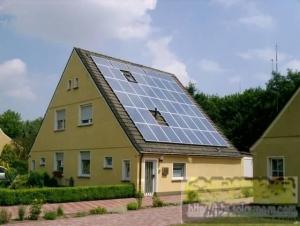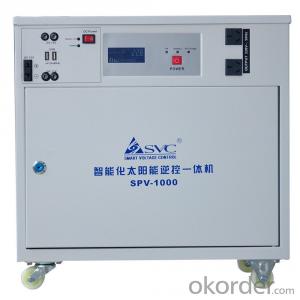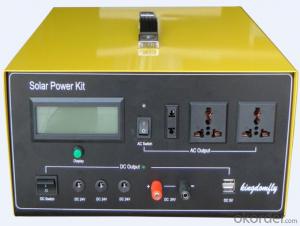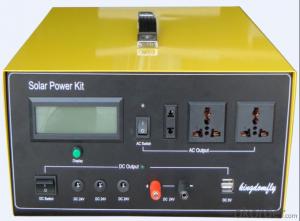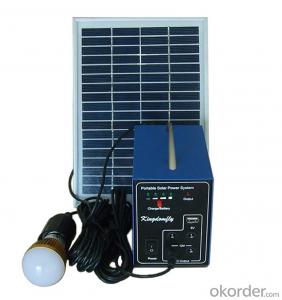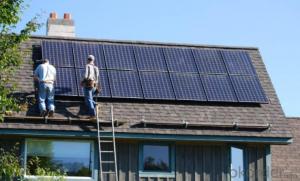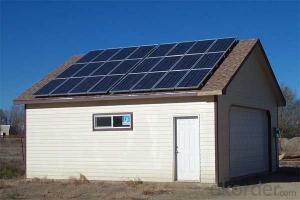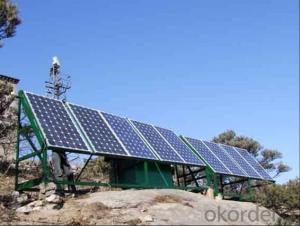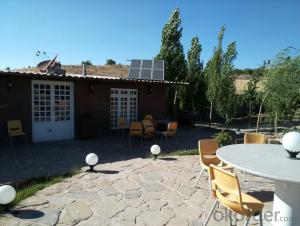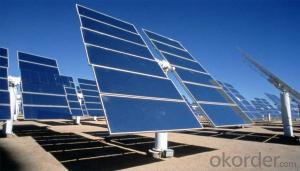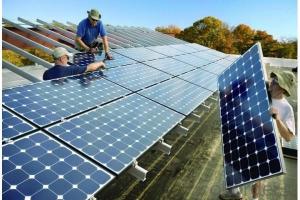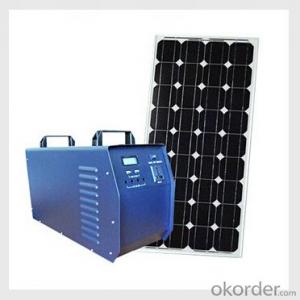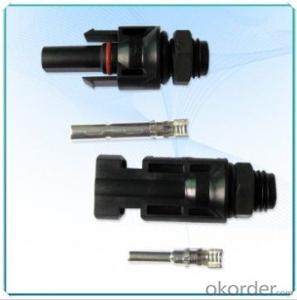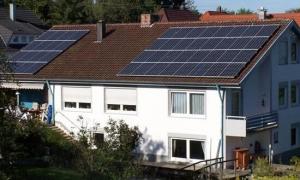Passive Solar Energy Systems - Off-Grid Solar Power System 500W High Efficiency
- Loading Port:
- China main port
- Payment Terms:
- TT OR LC
- Min Order Qty:
- 1 pc
- Supply Capability:
- 10000 pc/month
OKorder Service Pledge
OKorder Financial Service
You Might Also Like
1.Description of Product
Off-Grid Solar Power System is consisted of solar panel, solar charge controller, inverter, battery, mounting rack and cables.
(1).Grid-connected, send power to city grid
(2).MPPT technology, wide range of working voltage
(3).Simply Wiring, easy installation, customized design for your projects
(4).Low investment & long term feedback
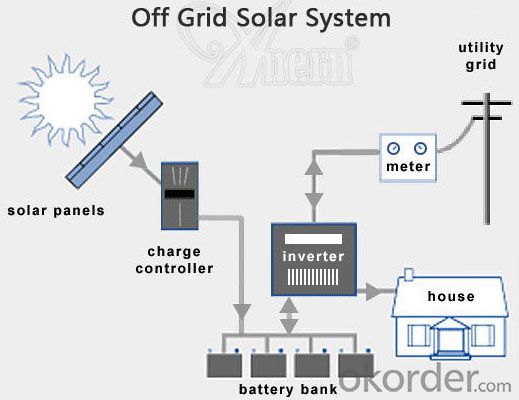
2. Off-Grid Features
1. Off grid solar power system is mainly used for application with relatively-small power consumption, and the areas have no grid network coverage, or grid power is unstable or outage condition.
2. It’s composed of solar panels, hybrid solar inverter, battery bank, solar panel mounting racks, and other accessories required fora complete home solar power system.
3. The battery bank gives a stable power output to the solar inverter which converts DC to AC to power loads, and provides power backup in rainy or cloudy days.
4. The solar panels generate electricity at daytime and charge the battery bank .
5. The off grid home solar power system provides grid power bypass in case of battery power shortage when sunshine is not enough.
6. All the off grid home solar power system configurations are worked out by scientific calculation and design.
The Product Parameter | |
Ref No. | 500W |
Solar Panel | Type: Monocrystalline Silicon PV Module Max Power: 250W QTY:2 pcs |
Controller-Inverter Integrator | Rated Ouput Power: 500W Rated DC Voltage: 24V QTY:1 pcs |
Battery | 12V/200AH per piece QTY:2 pcs |
Solar Panel Rack | Roof type mounting rack, anodized aluminum material, including complete fittings (Other type of racks can be customized as per client's requirement) QTY:1 pcs |
3.The Pictures of Product
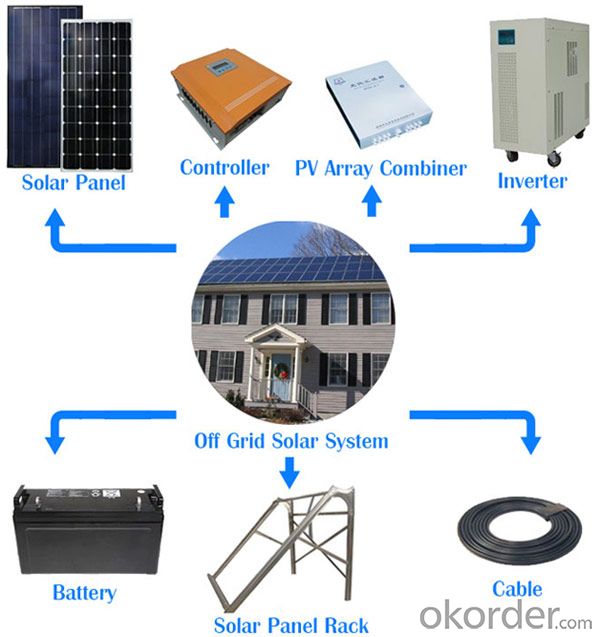

4.FAQ
Q1: What is the business type for the company?
A1: We are one of the biggest manufacturers inBejing.Chnia. Which is a high tech PV enterprise dedicated to the research, development, production and sales..
Q2: How long solar panel warranty can you offer?
A2: 10-Year product warranty,25-year linear power output warranty
If there is any quality problem, we will pay for freight and send free parts to you.
Q3: How many certificates do you have?
A3: We have 16 certificates,such as CE, TUV, UL, and so on.
Q4: Can I be the agent for you?
A4: Yes,We can discuss some information.
Q5: How to get a sample?How can cooperation with us
A5: contact us now.
- Q: Can solar energy systems be installed on schools or educational institutions?
- Yes, solar energy systems can be installed on schools or educational institutions. In fact, many schools and educational institutions around the world have already embraced solar energy systems as a sustainable and cost-effective solution for their energy needs. These systems not only help reduce electricity costs but also provide an opportunity for students to learn about renewable energy and environmental stewardship. Additionally, installing solar panels on educational institutions can serve as a visible commitment to sustainability, inspiring the wider community to adopt clean energy practices.
- Q: Can a solar energy system be installed in an area with a high bird population?
- Yes, a solar energy system can be installed in an area with a high bird population. However, certain precautions need to be taken to minimize any potential risks or issues. Birds may be attracted to the solar panels, perching on them or building nests. This can potentially lead to bird droppings and debris accumulating on the panels, reducing their efficiency. To mitigate these risks, there are various measures that can be implemented. One option is to install bird deterrents, such as spikes or netting, around the solar panels to discourage birds from landing or nesting on them. These deterrents should be designed in a way that does not obstruct the sunlight needed for the panels to generate electricity. Regular maintenance and cleaning of the solar panels can also help ensure their optimal performance. This includes removing any bird droppings, nests, or other debris that may accumulate over time. By keeping the panels clean, their efficiency can be maintained, and potential damage can be minimized. Additionally, it is important to choose a suitable location for the solar energy system installation. Placing the panels away from trees or structures that may attract birds for nesting purposes can help reduce the likelihood of bird-related issues. Overall, with proper planning, installation, and maintenance, a solar energy system can be successfully implemented in an area with a high bird population while minimizing any potential negative impacts on its functionality.
- Q: Are there any fire risks associated with solar energy systems?
- Yes, there are fire risks associated with solar energy systems, although they are relatively low. The most common fire risk is with faulty electrical components or improper installation, which can lead to short circuits or overheating. However, these risks can be minimized through proper installation, regular maintenance, and adherence to safety codes and regulations.
- Q: Can solar energy systems be installed in apartments or condominiums?
- Yes, solar energy systems can be installed in apartments or condominiums. However, the feasibility of installation may depend on various factors such as available roof space, structural considerations, and the willingness of the building management or homeowners association to accommodate the installation. In some cases, shared solar or community solar programs may be options for residents who cannot install solar panels on their individual units.
- Q: What is the impact of shade from nearby buildings or trees on the performance of solar panels?
- The impact of shade from nearby buildings or trees on the performance of solar panels is significant. When solar panels are shaded, even partially, their ability to generate electricity is greatly reduced. Shade causes a decrease in the amount of sunlight that reaches the panels, thereby reducing their efficiency. Shade on solar panels can result in a phenomenon known as "panel mismatch." This occurs when some parts of the panel receive sunlight while others are in shade. As a result, the shaded cells produce less electricity than the unshaded cells, leading to a drop in overall panel performance. The shaded cells can also become a source of resistance, causing the other cells to work harder to compensate and potentially leading to hotspots or damage. Furthermore, shade can cause a disruption in the electrical flow within the panels, which can negatively impact the entire solar power system. In the case of series-connected panels, if even one cell is shaded, it can significantly reduce the output of the entire array. This can result in a substantial loss of power generation and significantly affect the return on investment and payback period of the solar panel system. It is crucial to consider the shading factor when designing and installing solar panels. Shading analysis should be conducted to determine the potential areas of shade throughout the day and year. By avoiding or mitigating shading, the performance and efficiency of the solar panels can be optimized. Various measures can be taken to address shading issues. These include adjusting the tilt and orientation of the panels, trimming or removing nearby trees, or using technologies like micro-inverters or power optimizers that minimize the impact of shade on the overall system. In conclusion, the impact of shade from nearby buildings or trees on the performance of solar panels is significant and can greatly reduce their efficiency and power generation. It is crucial to consider shading factors during the design and installation process to optimize the performance and maximize the benefits of solar energy.
- Q: Can solar energy systems be used for powering electric vehicle taxi services?
- Yes, solar energy systems can be used to power electric vehicle taxi services. By installing solar panels on the roofs of taxi stations or charging stations, the energy generated can be used to charge electric vehicles. This not only reduces the carbon footprint of the taxi service but also lowers the operational costs by utilizing renewable energy.
- Q: Can solar energy systems be used for heating water in commercial buildings?
- Yes, solar energy systems can be effectively used for heating water in commercial buildings. Solar water heating systems use the sun's energy to heat water, which can then be used for various purposes in commercial buildings such as showers, sinks, and other hot water needs. These systems are cost-effective, environmentally friendly, and can significantly reduce the reliance on traditional fossil fuel-based heating methods.
- Q: How do solar energy systems impact energy affordability?
- Solar energy systems can significantly impact energy affordability by reducing monthly energy costs for homeowners and businesses. By harnessing the power of the sun, these systems generate electricity that can offset or even eliminate the need to rely on traditional energy sources. This leads to substantial savings on electricity bills over time, making energy more affordable for those who invest in solar. Additionally, solar energy systems can also contribute to overall energy affordability by reducing the strain on the electrical grid, which can help stabilize energy prices for everyone.
- Q: Can solar energy systems be used in areas with limited access to solar energy publications and resources?
- Yes, solar energy systems can be used in areas with limited access to solar energy publications and resources. While access to information and resources can be helpful, it is not a prerequisite for utilizing solar energy systems. Basic knowledge and understanding of the technology, combined with technical expertise, can enable the installation and maintenance of solar energy systems. Additionally, local communities can seek support from experts, organizations, or government agencies to bridge the knowledge gap and ensure successful implementation of solar energy systems in such areas.
- Q: Are there any risks of electromagnetic radiation with solar energy systems?
- Yes, there are minimal risks of electromagnetic radiation with solar energy systems. Solar panels generate direct current (DC) electricity, which does not emit electromagnetic fields (EMF) or radiation. However, some components of solar energy systems, such as inverters or power conditioning units, convert DC electricity to alternating current (AC), and may produce low levels of EMF. These levels are typically well below the safety limits set by regulatory bodies and pose no significant health risks to humans.
Send your message to us
Passive Solar Energy Systems - Off-Grid Solar Power System 500W High Efficiency
- Loading Port:
- China main port
- Payment Terms:
- TT OR LC
- Min Order Qty:
- 1 pc
- Supply Capability:
- 10000 pc/month
OKorder Service Pledge
OKorder Financial Service
Similar products
Hot products
Hot Searches
Related keywords
